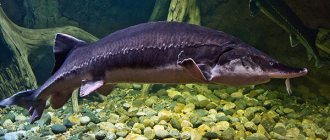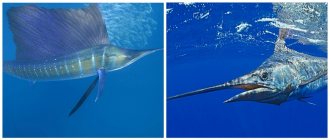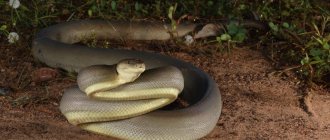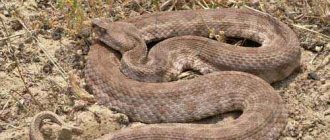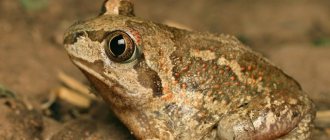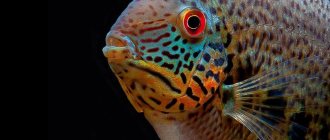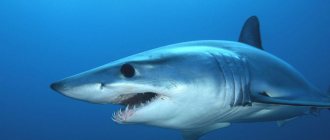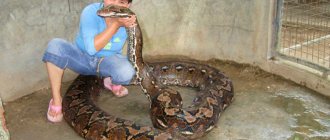The conger eel, or conger (European conger) is a large marine fish with a rounded, elongated cylindrical body. The most cold-loving species of the family. The body is long, compressed towards the end, the dorsal and anal fins are connected. There are no scales, the skin is smooth, covered with a layer of mucus. It lives both off the coast and in the open sea. It differs from the river eel in having a longer dorsal fin, starting almost immediately behind the pectoral fins. The conger is characterized by pointed pectoral fins and relatively large gill openings.
Appearance of a conger eel
The body is almost cylindrical, laterally compressed in the rear. The beginning of the dorsal fin is located above the end or immediately behind the end of the pectoral fins, closer to the base of the latter than to the base of the anal fin; the distance between the vertical of the beginning of the dorsal and anal fins significantly exceeds the length of the head; pectoral fins pointed. There are 275-300 rays in the dorsal fin of the conger eel, and 205-225 in the anal fin. The gill slits are relatively large. The mouth is large, the upper jaw is longer than the lower jaw, the lips are thick.
The teeth are well developed, laterally compressed. The anus is located noticeably behind the head. The Conger's eyes are well developed, covered with skin, small, elliptical in shape, located at the end of the first third of the head. The anterior pair of nostrils is located on short tubes near the top of the snout, the posterior pair is located immediately on the horizontal anterior-superior edge of the eye orbit (in front of the eyes). The tongue is smooth, compressed, free in the front. The lateral line is well developed and noticeable, running in the middle of the body.
What does an eel eat?
Eels are nocturnal and prefer to sleep in a secluded place during the day. By nature, they are voracious predators with powerful teeth. The diet is based on small fish, crustaceans and mollusks. They will not miss the catch caught in fishing nets. Lacking good eyesight, eel fish prefer to ambush prey, because thanks to their excellent sense of smell, they sense it from afar. There are species of eels that camouflage themselves with bottom vegetation. Digging a vertical hole in the ground with the help of a strong tail and leaning halfway out of it, sea eels wait for prey. In case of danger, they hide completely in the hole with lightning speed.
Distribution of the conger eel
The northern part of the Atlantic Ocean off the coast of Europe and Africa, as well as America and adjacent seas to depths of 300 m. Conger also lives in the Mediterranean and Marmara seas, the Bosphorus, from where single individuals enter the Black Sea. Near the American coast it is found from Cape Cod to Brazil. It is found in the Indian Ocean and off the coast of Asia in the Pacific Ocean, but is not found in the eastern half of the Pacific Ocean.
Moray and conger eel
Description, structure, characteristics
At the beginning of the last century, when Georges Blon asked his questions to the farmer, all of world science knew with complete certainty only why eels were so highly valued by gastronomes. They are just very fatty and tender: their tissue is 23 percent fat. Even the ancient Romans, who understood the joys of life, in particular loved and knew how to eat, considered moray eel one of the best decorations for their table. But moray eels are one of the types of eels. Terrible, disgusting in appearance, snake-like moray eels (with poisonous teeth!) lived in cages in the villas of the Roman rich, who did not take anything into account, as long as live fish was certainly used to prepare exquisite dishes.
One of the first who became interested in eels not from a consumer, but from a scientific point of view, was Aristotle. The first thing he notices is their strangeness and mystery. The eel, a typical river inhabitant, suddenly at a certain moment abandons its native fresh waters and goes to the sea. Where and why? Mystery, riddle... Further, all fish are divided into males and females. What about acne? They are asexual! No matter how much they were cut, not one could be found to have milk, caviar, or any genital organs at all. How do they reproduce? Riddle, secret... Fish die without water. And the eels come out into the air and crawl on land as if nothing had happened...
Nutrition
Conger is a voracious predator, feeding on small and medium-sized fish, living both in the water column and mainly in benthic forms. In addition to fish, it eats crustaceans, mainly crabs, lobsters, as well as mollusks (mainly octopuses), etc. and other inhabitants of the bottom. It catches fish from ambushes in rocks or stones, from where it suddenly rushes at a passing victim; often actively pursues its prey until it catches it. Its powerful teeth easily crush mollusk shells. At times he is not averse to taking advantage of other people's prey.
Habitats
Some families live in places with fresh water, such as ponds, rivers and lakes. When they are ready to breed, they travel or migrate to the salty waters of oceans and seas. However, many eels always live in salt water. Eels are found throughout the world.
In the spring they enter our ponds from the Baltic Sea and settle in river systems and lakes, where they usually live for six to ten years. They are bottom dwellers, meaning they are usually found on the muddy or sandy bottom of a body of water.
Another feature is the ability to sense temperature changes as low as 0.03°C.
Eels are carnivores (predators), that is, meat eaters. They feed mainly on bottom fauna (invertebrates) and small fish, but can swallow relatively large prey.
They readily eat various animals such as worms, snails, frogs, shrimp, mussels, lizards and other small fish. They hunt for food at night.
Economic importance
Minor. It is extremely rarely caught in the Black Sea. It is caught mainly by trawls. Conger eel meat is less valuable than river eel meat; it is fibrous and contains less fat. Sea eel is consumed fresh, salted and smoked. Just like other eels, the blood and mucus of the conger eel contain harmful substances, so during processing this fish must be bled and washed.
Literature: 1. Lebedev V.D., Spanovskaya V.D., Savvaitova K.A., Sokolov L.I., Tsepkin E.A. Pisces of the USSR. Moscow, Mysl, 1969 2. K. Kukhorenko, Y. Komarov. Commercial fish of the eastern tropical Atlantic. Kaliningrad book publishing house, 1966 3. Commercial fish of Russia. In two volumes / ed. O.F.Gritsenko, A.N.Kotlyar and B.N.Kotenev. - M.: VNIRO publishing house. 2006.- 1280 p. (Vol. 1 - 656 pp.). 4. Vasilyeva E.D. Nature of Russia: animal life. Fish. - M.: LLC "Firm Publishing House ACT", 1999. - 640 p. 5. Methodological materials for identifying deep-sea bottom fish in the open part of the North Atlantic. - Murmansk: PINRO, 1986. - 222 p. 6. Wheeler A. Key to fish in marine and fresh waters of the North European Basin. Per. from English Preface and comment. V. P. Serebryakova. - M.: Light and food industry, 1982. - 432 p., ill. 7. Fauna of Ukraine. In 40 volumes. T.8. Fish. Vol. 3. Loach, catfish, ictaluridae, freshwater eels, conger, garfish, cod, stickleback, needlefish, gambusiaceae, zeusaceae, sphyrenes, mullet, silverside, bugs / Movchan Yu.V. - Kyiv: Nauk, Dumka, 1988. - 368 p.
Reproduction and lifespan
Regardless of whether the fish live in the river or the sea, they always reproduce in the sea. Their age of sexual maturity ranges from 5 to 10 years. The river eel returns to the sea during spawning, where it lays up to 500 thousand eggs and dies. The eggs, 1 mm in diameter, float freely in the water.
The favorable temperature at which spawning begins is 17º C. The conger eel lays up to 8 million eggs in the water. Before puberty, these individuals do not display external sexual characteristics, and all representatives are similar to each other.
Little is known about the reproduction of the electric eel; this species of marine fauna is poorly studied. It is known that when preparing to spawn, an eel goes deep to the bottom and returns with already stronger offspring that can already emit charges.
There is another theory according to which the eel weaves a nest from saliva; up to 17 thousand eggs are placed in this nest. And those fry that are born are the first to eat the rest. Electric eel what kind of fish - they will ask you, you can answer that even scientists do not know this.
Eel meat is very healthy to eat; its composition is diverse in amino acids and microelements. Therefore, lately lovers of Japanese cuisine have paid attention to it.
Although the price of eel fish is not small, this does not reduce demand in any way, although its catching is prohibited in many countries, which is why it is raised in captivity. In Japan, they have been doing this for a long time and consider this business to be profitable, since the cost of feeding eels is not high, and the cost of its meat is much higher than expenses.
In culture[edit]
The great lake Almere, which existed in the early medieval Netherlands, took its name from the eels that lived in its water (the Dutch word for eel is aal or ael, therefore: "aelmer" = "eel lake"). The name survives in the new city of Almere in Flevoland, named in 1984 in memory of this body of water on the site of which the city is located.
The daytime passage of rivulets upstream along the Thames was at one time called "eels". The word "elver" is considered a corruption of the word "eel". [8]
A famous landmark on the French Polynesian island of Huahine (part of the Society Islands) is a bridge over a stream that is home to three to six foot long eels that are considered sacred in local culture.
Eel fishing in Nazi-time Danzig plays an important role in Günter Grass's novel The Tin Drum
. Human mistreatment of eels is used as a metaphor for Nazi atrocities, and the sight of eels being killed by a fisherman causes the protagonist's mother to go mad.
The sinister consequences of eel fishing are also mentioned in Jo Nesbø's cockroaches
, the second book in the Harry Hole mystery series. The book's story involves a Norwegian village where eels in the nearby sea are rumored to feed on the corpses of drowned people, so eating these eels borders on cannibalism.
Spawning
At the very beginning of the last century, the young Danish biologist and oceanographer Johannes Schmidt (he was not even thirty years old at the time) studied the reproduction of commercial fish that are found in the northern European seas. A conical net with very small cells was lowered from the side of the ship. After some time, the net was lifted on board, and the most thorough sorting of everything that came into it began. First large fish, then small fish, after them fry, larvae - and so on until the smallest prey, right down to individual eggs. Patiently and methodically, all this was collected in jars, counted and the results were recorded in a journal.
In 1904, while sailing on the ship "Thor" in the Faroe Islands, between Iceland and the coast of Scotland, Schmidt caught a leptocephalus. Just one. It would seem, what does it mean to catch one fish during the entire expedition season? But Schmidt, with the unerring instinct of a true scientist, realized that this could be the tip of a thread, by pulling which it would be possible to unravel the whole tangle. After all, for the first time a leptocephalus was caught not in the Strait of Messina. And Schmidt managed to convince the members of the Danish Marine Research Commission that from now on the main goal of his work should be to search for the place where eels spawn. “Back then I still had very little idea,” Schmidt later wrote, “what exceptional difficulties would stand in the way of solving this problem.”
In 1905, "Thor" sailed in more southern areas. This time we managed to catch several hundred leptocephali. Some of them were already in the process of transformation, although they were still easy to recognize. Schmidt realized that the eels were spawning somewhere far out in the open ocean. But where?
The 1906 season did not produce anything new, but thoroughly confirmed the previous results. For the entire next year, Schmidt did not go to sea at all. True to his method, he spent the entire year carefully examining the material caught under
microscope. That's when all the fuss with preserving the catch on board paid off a hundredfold! Having studied leptocephali caught in various places, Schmidt discovered that they, as one, were surprisingly similar to each other. This was a very important circumstance. It indicated that there was only one species that could be called the European eel. Schmidt's instinct told him that all eels spawned in one place, most likely somewhere in the center of the Atlantic Ocean.
The scientist’s next step might seem paradoxical: from 1908 to 1910, Schmidt again organized expeditions, but where? To the Mediterranean Sea, although he was sure that eels breed in a completely different place. During two seasons spent in the Mediterranean Sea, Schmidt irrefutably proved that eels do not spawn here. All caught leptocephals turned out to be very large. Moreover, if we compare the size of the larvae with the place where they were caught, we get a very clear picture: the further from Gibraltar, the larger the leptocephali. Therefore, they all really come from the Atlantic.
Now it was possible to methodically search the Atlantic Ocean. From the Faroe Islands to the Azores, from the Azores to Newfoundland, from there to the Antilles archipelago - these are just some of Schmidt's routes. There were also shipwrecks, when only by miracle it was possible to save people and collected materials. But nothing could stop the obsessed Dane from moving towards his goal. Even before the outbreak of the First World War, the mystery that hid the eel spawning site was solved. This place turned out to be the Sargasso Sea: near it the smallest leptocephali were caught, which had just hatched from eggs. True, Schmidt considered himself entitled to finally declare this only in 1920.
Links[edit]
- ^ ab Froese, Rainer and Daniel Pauly, eds. (2009). "Anguilliformes" at FishBase. Version January 2009
- Pl. 661 in Garceau, FAP 1764. Figures of plants and animals used in medicine, decrees in medical medicine by Mr. Geoffroy, medical drawings by Mr. de Gazo, graves of couples by Ms. Defert, Prevost, Duflos, Martinet, etc. Niquet scrip. [5]. - With. [1-4], index [1-20], table. 644-729. Paris.
- ^ ab McCosker, John F. (1998). Paxton, Jr.; Eschmeyer, W. N. (ed.). Encyclopedia of Fishes
. San Diego: Academic Press. pp. 86–90. ISBN 0-12-547665-5. - Jump up
↑ Long Jr, J. H., Shepherd, W., & Root, R. G. (1997).
Maneuverability and reversible movement: how an eel-like fish swims back and forth using traveling body waves." In: Proceedings of the special session on bioengineering research related to autonomous underwater vehicles
, 10th international symposium (pp. 118–134). - Prosek, James (2010). Acne: A Study
. New York: HarperCollins. ISBN 978-0-06-056611-1. - Sea conger, European conger eel: fisheries, game, aquarium. Fishbase.org
- Fishbase Archived November 10, 2013 at the Wayback Machine. FishBase (November 15, 2011).
- ^ab Campbell, Lady Colin (1886). The Book of Running Brook and Still Waters. New York: O. Judd, pp. 9, 18.
- ↑
Inoue, Jun G.;
and others. (2010). "Deep-sea origins of freshwater eels". Biol. Lett. 6
(3): 363–366. DOI: 10.1098/RSBL.2009.0989. PMC 2880065. PMID 20053660. - Nelson, Joseph S.; Grande, Terry S.; Wilson, Mark VH (2016).Fishes of the World (5th ed.). John Wiley and Sons. ISBN 9781118342336.
- Johnson, G.D.; Ida H.; Sakaue J.; Sado T.; Asahida T.; Mia M. (2012). "Living fossil eel (Anguilliformes: Protanguillidae, fam nov) from an underwater cave in Palau". Proceedings of the Royal Society
. (in press) (1730): 934–943. DOI: 10.1098/rspb.2011.1289. PMC 3259923. PMID 21849321. - Frese, Rainer and Pauly, Daniel, eds. (2012). "Anguilla rostrata" in FishBase. Version from May 2012
- "Anguilla rostrata". Integrated Taxonomic Information System. Retrieved May 20, 2015.
- "IUCN Red List of Threatened Species". IUCN Red List of Threatened Species
. Retrieved October 25, 2022. - Frese, Rainer and Pauly, Daniel, eds. (2012). "Anguilla anguilla" in FishBase. Version from May 2012
- Anguilla (Linnaeus, 1758) FAO, types of facts. Retrieved May 20, 2012.
- "Anguilla Anguilla". Integrated Taxonomic Information System. Retrieved May 20, 2012.
- Freyhof, J Kottelat M (2010). "Anguilla-Anguilla". IUCN Red List of Threatened Species
.
2010
. Retrieved May 20, 2012.CS1 maint: multiple names: authors list (link) Old form URL - Frese, Rainer and Pauly, Daniel, eds. (2012). "Anguilla japonica" in FishBase. Version from May 2012
- ↑
Anguilla japonica, Temminck & Schlegel, 1846 FAO, Species Fact Sheet. Retrieved May 2012. - "Anguilla Japanese". Integrated Taxonomic Information System. Retrieved May 20, 2012.
- Jacoby, D. & Gollock, M. (2014). "Anguilla Japanese". IUCN Red List of Threatened Species
.
2014
: e.T166184A1117791. DOI: 10.2305/IUCN.UK.2014-1.RLTS.T166184A1117791.en. Retrieved January 4, 2018. - Frese, Rainer and Pauly, Daniel, eds. (2012). "Anguilla australis" in FishBase. Version from May 2012
- "Anguilla australis". Integrated Taxonomic Information System. Retrieved May 20, 2012.
- Aku, Anthony et al. "Quality assessment of European silver eels and a preliminary approach to trace the origin of contaminants - a European review." Environmental science in general. 743 (2020): pp. Internet.
- https://www.buber.net/Basque/Food/food1.html
- Champken, Neil (2 June 2006). “Would you pay £600 for a handful of baby eels?” . theguardian.com
. Retrieved April 7, 2015. - Leake, Jonathan (February 7, 2015). "EU eel order costs UK £100m". Sunday Times
. Retrieved April 7, 2015. - "Poison in the Eel's Blood" (PDF). April 9, 1899. Retrieved January 22, 2010.
- "Severe eel (mentioning that 'only 0.1 ml/kg is enough to kill small mammals such as rabbits...' BBC online
. Retrieved 22 January 2010. - "Eel blood serum." M. Sato. Nippon Biseibutsugakukai Zasshi (1917), 5 (No. 35), Source: Abstracts Bact. 1, 474 (1917)
- "Hemolytic and toxic properties of some sera." Wm. J. Keffer, Albert E. Welsh. Bulletin of Mendel (1936), 8 76–80.
- "Charles Robert Richet". encyclopedia.com.
- snopes (December 4, 2015). "Eel demagnetizes: snopes.com". Snopes
. Retrieved April 21, 2010. - Barss, William (1993), "Pacific Hagfish, Eptatretus stouti and Black Hagfish, E. deani: Oregon Fishery and Port Observation Sampling, 1988-92", Marine Fisheries Review
(Fall, 1993), retrieved April 21, 2010 - "Greenpeace Seafood Red List". Greenpeace International
. - "Indonesian eel hot item for smugglers". The Japan Times. Retrieved July 30, 2013.
- Katz, J. (1998). "How to be a dragon the Indo-European way: the Hittite Illuyan women and their linguistic and cultural relatives in Latin, Greek and Germanic." In Jasanova; Melchert; Oliver (ed.). World Curad. Studies in Honor of Calvert Watkins
. Innsbruck. pp. 317–334. ISBN 3-85124-667-5.
